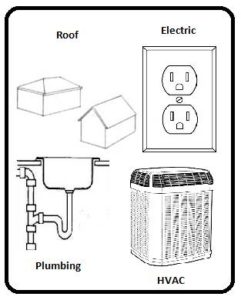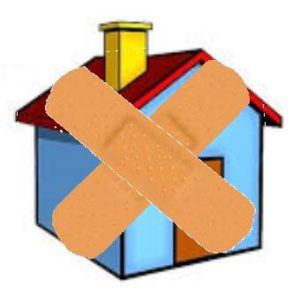State Farm’s New Policy
 The Four Point Insurance Inspection shows the insurance company that the house is insurable. It consists of visual inspections of the (1) Roof (2) Electrical System (3) Plumbing and (4) HVAC System. While some companies were allowing a home to be 30 or even 50 years old before requiring a 4 Point Inspection, others sometimes required that inspection for homes only a few years old, especially bank foreclosures &/or homes that have been vacant for a while.
The Four Point Insurance Inspection shows the insurance company that the house is insurable. It consists of visual inspections of the (1) Roof (2) Electrical System (3) Plumbing and (4) HVAC System. While some companies were allowing a home to be 30 or even 50 years old before requiring a 4 Point Inspection, others sometimes required that inspection for homes only a few years old, especially bank foreclosures &/or homes that have been vacant for a while.
As of 01 July 2018, State Farm now requires a Four Point Insurance Inspection on any home over 10 years old, and initial reports indicate that many other insurance companies throughout Florida are soon going to require the same.
4 Point is a Separate Inspection

Yes, a Standard Home Inspection covers the “4 points” in a 4 Point Insurance Inspection. However, they are 2 separate inspections. The client (usually a buyer) wants to know everything about the house, while the insurance company just wants to know that it is “insurable.”
In other words…
(1) You should not give the Insurance Agent a copy of the Standard Home Inspection – it will include way more info. than underwriting needs, and could cause them to question areas of the home that they usually wouldn’t care about.
(2) We cannot simply cut & paste those 4 points out of the Standard Home Inspection – The insurance company requires the inspector to note and record current operating condition, make, model, serial number, age, building code used when each area was last updated (which requires a permit search), expected service life, etc. Plus additional photos and a standardized form are required.
Here’s the good news
While many inspectors will charge for a 4 Point Inspection even if it doesn’t benefit the client…
WE DON’T DO THAT!
If we are conducting a Standard Home Inspection & we determine that the home won’t pass a 4 Point Insurance Inspection, then we’ll skip that inspection & explain on the Standard Home Inspection Report what repairs will be needed, rather than charging for an inspe
ction that isn’t going to do any good.
“But I Need a 4 Point Inspection for my Insurance Company“
Yes, you need one that PASSES.
If the house will fail, then home owners simply need to make repairs 1st, but buyers have 3 options:
(1) Negotiate with the sellers to make repairs – then call us back to do the 4 Point.
(2) Find an insurance company that doesn’t require a 4 Point – they’re out there. Their premiums are ridiculous (because they insure properties that are “un-insurable”) but it’s just a temporary solution so that you can get an insurance binder, close on the home, make repairs, then get the 4 Point & normal insurance.
(3) Find an insurance company that will accept a FAILING 4 Point, but will give you 30, 60, or 90 days to make repairs.
What to Look For
Of course, home owners, buyers, Realtors can’t conduct a 4 Point Insurance Inspection, but it doesn’t hurt to know what the Home Inspector will be looking for.
Below are a just few brief examples of issues that could make the home “un-insurable.”
Roof
- Leaks
- Heavily worn, damaged, or missing roof covering
- Roof deck has wood rot
- Sag between trusses / rafters
- 3+ layers of roof covering
- Less than 3 years of remaining useful life
Electrical
- Main Panel is not grounded
- Electrical panels or breakers manufactured by Federal Pacific Electricalor Zinsco
- Smoke detectors missing or don’t work properly
- Outlets not working or not properly wired (no ground, neutral reversed, etc.)
- Outlets missing cover plates or exterior outlets missing weather covers
- < 100 Service amps
- Knob & tube or aluminum branch circuit wiring
- Missing GFI protection in ALL“wet areas” / GFI’s don’t work properly
- Exposed wires (INCLUDING ceiling light / fan fixtures)
Plumbing
- Leaks
- No TPR valve on water heater
- Main shut off valve to house is missing or does not work
- Polybutylene
- Shut off valves (under counters / behind toilets) are stuck or don’t work
- Heavy corrosion on water supply lines &/or to/from water heater
- Poor water pressure &/or slow draining sinks, tubs, showers
Air Conditioning
- Does not heat properly / does not cool properly
- Drain pan is full of water
- Portable units (as primary)
- Dirty or corroded coils
- Condensation / poorly insulated unit &/or return lines

